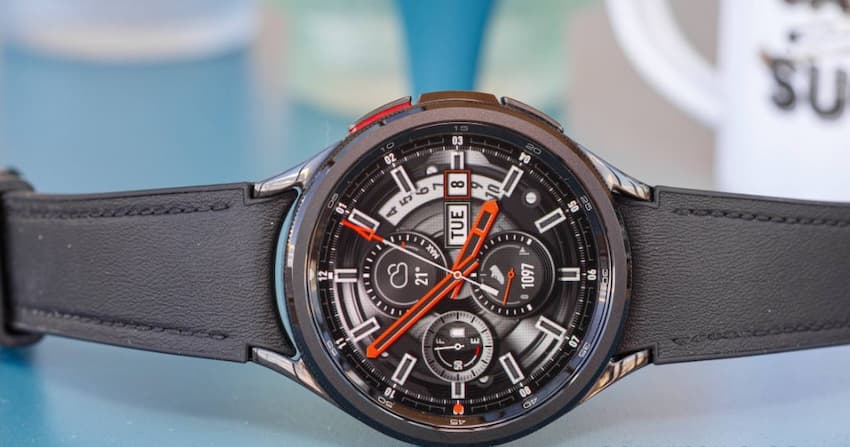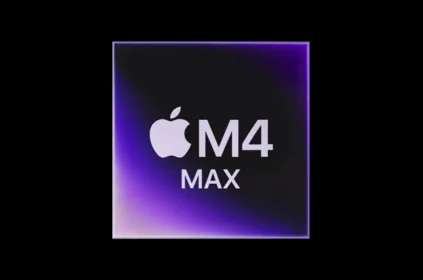You planning on buying yourself a Samsung Galaxy Watch6 Classic? Then here is a review you must read.
Meanwhile, find below the specs at a glance:
- Body: 46.5×46.5×10.9mm, 59g; Sapphire crystal front, stainless steel frame; MIL-STD-810H compliant, 50m water resistant (IP68), ECG certified, Blood pressure monitor.
- Display: 1.50″ Super AMOLED, 480x480px resolution, 9:9 aspect ratio, 453ppi; Always-on display.
- Chipset: Exynos W930 (5 nm): Dual-core 1.4 GHz Cortex-A55; Mali-G68.
- Memory: 16GB 2GB RAM.
- OS/Software: Android Wear OS 4, One UI Watch 5.
- Rear camera: No.
- Front camera: No.
- Video capture: Rear camera: No.
- Battery: 425mAh; Wireless (Qi).
- Connectivity: LTE; eSIM; Wi-Fi 4; BT 5.3; NFC.
- Misc: Accelerometer, gyro, compass, heart rate, barometer, thermometer (skin temperature), 3D Hall sensor; Natural language commands and dictation, Samsung Pay.
Introduction And Unboxing:
Samsung has thankfully reconsidered, and it brought back the unique rotating bezel for the new Galaxy Watch6 Classic after scrapping it with the Galaxy Watch5 Pro.
This is perhaps the biggest change in the new Galaxy Watch6 Classic, along with the new Exynos W930 for wearables.
However, we can’t shake off the feeling that Samsung may be running two separate Galaxy Watch flagship lineups – Pros and Classics.
After all, a two-year upgrade cycle is the norm, and the company is probably targeting Galaxy Watch4 Classic owners with this one.
READ ALSO: Samsung Unveils Foldable Smartphones
Those who are not interested in the rotating ring (anyone?) can stick to the Pro series.
The concept of two watch lineups could well explain why Samsung sees no issue in reducing the battery capacity of the Watch6 Classic down to 425 mAh from 590 mAh on the Watch5 Pro.
It’s because it’s still an upgrade over the Watch4 Classic from 2021, which had a 361 mAh cell.
Samsung believes the new chipset is more efficient, which we’ll put to the test in our battery section of the review.
Efficiency is one thing, but what about performance? Well, the new Exynos W930 offers higher clock speeds and is paired with 2GB of RAM, instead of 1.5GB in the previous two generations.
This ensures smoother visuals and faster operation.
Speaking of visuals, the display is now bigger – 1.5″ and with a higher resolution to match (480 x 480px).
And on the fitness-tracking front, not much has changed except the added skin temperature measurements.
Fall detection is a new feature too, which may be facilitated by the new 3D Hall sensor.
A new Wear OS 4.0 with Samsung’s proprietary One UI Watch 5 software ties everything together while the rest of the device is practically unchanged.
Of course, there are nuances, and that’s why we have this review, so keep reading.
Unboxing the Galaxy Watch6 Classic

Samsung Galaxy Watch6 Classic review
The device comes in a pretty standard retail box containing just the user manuals and the charging pad with a cable attached.
The only change this year is that the cable is now USB-C instead of USB-A.
There’s no dedicated charger in the box, but you can use pretty much every USB-C wall charger or a PC/laptop.
Once again, charging the watch with a third-party Qi charger is impossible, and another limitation is you can’t reverse wireless charge with a non-Samsung phone.
Design and usability:
Essentially, the design of the top-tier Galaxy smartwatches (Pro and Classic series) hasn’t changed much; it’s a good old circular classic design with only minor changes mostly related to the rotating bezel.
And to be fair, it’s not as if Samsung can go wild with the design. There’s not a lot of wiggle room.
Having said that, the Galaxy Watch6 Classic is unique in some ways.
For instance, it’s the heaviest Galaxy Watch ever, tipping the scale at 59 grams.
That’s true if you don’t take into account the Gear series.
Either way, the change is noticeable only when comparing it to the Watch5 Pro, which had a much lighter titanium frame.
The Watch6 Classic is also bigger now, technically 47mm form factor, or 46.5mm, to be exact. Samsung made good use of the extra space and grew the display to 1.5″, which is surprisingly noticeable.
The display is sensibly bigger compared to the older versions, and the thinner bezel (30% slimmer) makes the Watch4 Classic and Watch5 Pro look clunky, even.
As a result, the rotating bezel is much thinner now too and as per Samsung, it’s 15% slimmer.
We would like to once again point out one big advantage of Galaxy Watches with rotating bezel – it protects the display.
Many people would often brush their watches in corners, furniture, walls, etc., and the bezel is usually the one to take most of the hits.
The bezel itself is easily replaceable at home. Additionally, the display is also protected by a sapphire glass sheet.
The strap is a big step in the right direction, but it’s still not there yet. For the asking price, the strap is still somewhat cheap.
It’s made of a soft-touch silicone, but it’s much better than the Watch4 Classic.
Firstly, the underside is very pleasant to touch while the outer surface imitates leather.
There’s even stitching running along the edges for a more convincing look.
There are even tiny release buttons for easier attaching and detaching if you need to swap the straps more frequently.
The device uses 20mm standard straps like its recent predecessors, confirming the 22mm straps of the older models are a thing of the past.
Depending on the market, Samsung itself offers a wide variety of strap designs in case the ones from third-party manufacturers don’t cut it.
As usual, the Galaxy Watch6 Classic is water and dust-tight (IP68) and complies with the MIL-STD-810H standard.
There was no change in overall protection compared to the previous models.
It’s important to note that this military-grade standard does not guarantee ruggedness in extreme conditions.
All in all, the Watch6 Classic feels like a normal watch, doesn’t get in the way if you have larger wrists, and despite the added weight, it is still light enough not to be obstructive.
Currently, the Watch6 Classic comes in just two colors – Black and Silver.
Usability and controls
We noticed a few changes to the bezel’s behavior.

Samsung Galaxy Watch6 Classic
It’s a tad clickier and has longer travel between each click, which in turn, makes navigation feel a tad weird.
There’s less resistance to it.
We can’t say we are a fan of the longer travel because you now have to spin the bezel more to scroll down or navigate, compared to the Watch4 Classic.
Still, if you are a fan of the rotating bezel navigation, you will like this one too.
It doesn’t require getting used to at all and feels natural.
Also, there are fewer smudges on the display as you won’t be touching it for scrolling and most navigation.
The buttons on the right side are also clickier in a way and less mushy when pressing.
The top, red-accented one is for going back to the home screen, while the bottom serves as a “back” button.
The latter can be re-assigned to open the recent apps menu.
A double press of the home button can launch an app of your choice, while a press and hold can summon Bixby, Google’s Assistant or the power-off menu.
Hardware and sensors
After two generations of running on the Exynos W920, the new Galaxy Watches now rely on a more powerful and supposedly more efficient Exynos W930 SoC.
The new chip is still based on the 5nm manufacturing process, but the dual-core Cortex-A55 CPU is now ticking at 1.4 GHz instead of 1.18 GHz even if with the same Mali-G68 GPU.
The internal storage remains 16GB and operating memory is now 2GB instead of 1.5GB.
It’s either this or the more polished software (or maybe both?), but the Galaxy Watch6 Classic feels way smoother than its predecessors. Animations are fluent and navigation is fast and snappy.
The most obvious change, however, is the display.
It’s now 1.5″ in diagonal, and although that doesn’t sound much on paper, it’s definitely a noticeable change coming from the Galaxy Watch4 Classic, or the Watch5 Pro, for that matter.
The OLED panel has higher resolution to match the new diagonal too – 480 x 480px.
In addition to the said hardware, the device incorporates a slew of sensors, most of which are not new.
The Galaxy Watch6 Classic is equipped with an accelerometer, gyro, compass, heart rate, barometer, thermometer (for skin temperature) and a 3D Hall sensor.
The latter is a new addition to the list and although Samsung didn’t specify why the new Galaxy Watch6 Classic has a 3D Hall sensor, it’s fairly obvious that it’s used for more accurate tracking and positioning.
It’s essentially a 3D magnetic position sensor that can detect the strength of the magnetic field on the x-,y- and z-axes.
It can measure three-dimensional, linear, angular, and rotational movements.
It’s important to note that the temperature sensor can be used for more than just skin temperature. Samsung has opened up its Skin Temperature API to developers and partners, so they can develop apps taking advantage of this new functionality.
The Thermo Check app, for instance, allows users to measure the temperature of their meal or the ocean before dipping their toes.
Since the sensor works with infrared, the watch doesn’t have to be in contact with the surface.
The so-called BioActive sensor is also on board to measure your body composition.
Electrodes on the bottom of the watch and inside the two buttons help measure water through impedance and assess your body composition in terms of lean muscle mass, body fat percentage, water weight, BMI and even basal metabolic rate.
It takes just 15 seconds to do 2,400 measurements to figure out those. More about accuracy and usability on the next page.
Last, but not least, a few good words about the vibration motor. It seems to be pretty strong, crisp and precise.
Samsung has worked on the haptics, and it shows – over the course of our testing, we were able to distinguish the different taps and buzzes from the watch – when using the virtual bezel, notifications, incoming calls, navigation through the menus, etc.
Moreover, NFC payment works great this time around.
We don’t know whether Samsung moved the NFC chip or upgraded it, but the watch is so much easier to use for contactless payments now.
Battery life
Battery life is a mixed bag. The Galaxy Watch6 Classic offers a small upgrade over the Galaxy Watch4 Classic in terms of total capacity (361 mAh vs. 425 mAh).
But compared to the Galaxy Watch5 Pro, it’s a noticeable downgrade, which has a 590 mAh cell.
Our first-hand experience with the watch on day-to-day usage confirms the downgrade from the Galaxy Watch5 Pro.
We were able to squeeze out only 48 hours or a bit more than that on a fully charged battery.
For context, the watch’s display was set to automatic brightness, raise-to-wake function active, at least one 2-hour long indoor workout, some steps/walking outside, heart rate measurement every 15 minutes and sleep tracking at night.
We also didn’t use the power-saving mode – we just let the battery run completely empty.
The Always-on display cuts the runtime in half.
That’s roughly the same battery life we get from the Galaxy Watch4 Classic.
The Galaxy Watch5 Pro, on the other hand, has about 72 hours on a single charge, so it’s sad to see the Watch6 Classic taking a step back in this regard.
Samsung’s One UI Watch 5 on top of Wear OS 4
Tizen OS is long gone, so there’s no reason to mention it anymore. At first, we were missing Tizen, but after three iterations of Samsung’s One UI Watch, we no longer do.
The new One UI Watch 5 based on Google’s Wear OS 4 is more polished and fluent than ever.
Sure, the changes are rather minimal coming from the previous OS version but are worth noting.
The new Galaxy Watch6 Classic is notably faster and smoother in everyday navigation, which also probably due to the higher CPU clock speeds and that extra 0.5GB of RAM.
From a UI standpoint, not much has changed.
Even the iconography is the same. Although, there’s a minor but noticeable change in the font.
It’s now bold in most places and it’s somewhat easier on the eyes. Legibility is better this way.
Anyway, you can find the quick toggles when you swipe down from the top edge of the display, you can set up and arrange widgets (or Tiles, whatever you like to call them) to your liking.
You can use swipe gestures or rotate the bezel when cycling through them.
A left turn of the bezel from the home screen will open up the notification pane.
Speaking of the “home screen”, that’s actually the watch face you choose.
Like every new smartwatch release, Samsung is bringing newly designed watchfaces in different categories so you will probably find some that would fit your style.
Luckily, since Wear OS is maturing, so is the modding community. You will find plenty of customized and customizable watch faces on Google Play.
Swiping from the bottom brings out the app drawer, which can also be re-arranged to your liking, while the general Settings menu poses no changes.
However, most of the features and functionalities can be found in the Galaxy Wearable app.
Stuff like notification handling, sound and vibration, accounts and backup, battery and advanced features.
The Advanced features sub-menu allows you to customize the action of the two buttons – double press, single short press or long press.
There are three wrist gestures too, which aren’t new.
One for answering calls, one for dismissing calls and another one that launches an app of your choice.
We found the latter to misfire often and the watch often registers an unintentional gesture.
We are happy to report that Samsung’s notification handling remains unrivaled.
Each and every app has its own icon (it even syncs the icons with the ones on your phone), and the person who is messaging you has the avatar centered, so you know who it is in an instant.
Stickers and received images also get through from the most popular messaging apps. Quick replies are also an option.
You can also sync your Do Not Disturb or Bedtime modes, so once you turn them on either device, they will be active on the other.
One thing we don’t like about the new notification card styling.
It doesn’t go well with the circular design. It’s a really small issue and a subjective one at that, but we liked the style of the previous messages better.
It didn’t have any cards or styliing complications – messages appeared on the circular screen, and the UI seemed seamless.
All in all, we liked Samsung’s latest software, and we didn’t find any annoying or deal-breaking bugs this time around.
While previous versions had some issues, this iteration seems to be pretty stable and solid in this regard. Fluent and trouble-less operation.
Samsung Health and fitness tracking
Samsung’s Health app and its features have come a long way.
The company has expanded on the vitals it tracks and has improved fitness tracking over the years.
The Health app on Android phone is also more polished, informative and better in every way.
However, we still can’t get over the fact that the Samsung Health widgetс on the phone doesn’t give you information about steps, sleep and heart rate for the past few days or week.
You have to open the Android app to see such simple stats.
Alongside the ECG and blood pressure measurements, which are not available only when paired with a Samsung phone, the new Galaxy Watch6 Classic also brings irregular heart monitoring and skin temperature measurements during sleep.
The former is once again available only to Samsung phone owners.
Speaking of sleep, Samsung has worked to improve its sleep measurements, which weren’t very accurate, to begin with.
But that’s usually the case with home-grade devices.
In our experience, you can only rely on the total sleep time data – bedtime and wake-up times are also very accurate.
Data like deep sleep, REM sleep, etc., is largely unreliable.
Anyway, in addition to the already existing sleep score, which has also been improved as per Samsung, you get a sleeping coach.
Once you get a full week of sleeping data, the Health app will offer you coaching that focuses on fixing issues with your sleep.
Those can vary a lot – inconsistent sleeping schedule, frequent awakening, not enough deep sleep, etc.
Once the software analyzes your sleep, it assigns a Sleep Animal Symbol and tips on how to improve your sleep.
In case your watch is connected to smart home appliances, you can set it to automatically kick off Sleep Mode, which would mute your phone’s notifications and turn off the lights in the house.
A new personalized heart rate zone is also new on the menu.
The watch will identify the heart rate zones for you (as they vary depending on your fitness level and age, among other factors) and guide you on your next run so you can stay within the desired heart rate zone. You can even build a custom workout routine.
The irregular heart rhythm function mentioned earlier is limited to certain countries as it requires additional certification from local regulatory bodies.
As of now, only users in Argentina, Azerbaijan, Costa Rica, Dominican Republic, Ecuador, Georgia, Guatemala, Hong Kong, Indonesia, Panama, UAE, as well as Korea and the US, can make use of the feature.
In other markets, this functionality will only work in the background and send notifications to users if an irregular rhythm is detected.
Two things to note here. Just like ECG and blood pressure, the IHR feature works only with Samsung phones with the additional Samsung Health Monitor app that can only be downloaded from the Galaxy Store.
And, of course, Samsung states that all these features can’t be used to diagnose or treat certain illnesses. They are only used to guide you and encourage you to visit a licensed physician.
The watch also has a Fall Detection feature.
The Watch6 Classic can alert emergency services if it detects a fall during a workout, normal daily activity or even when sleeping.
It can also call someone from your emergency contact list.
When it comes to body composition measurements, it’s not something new or worth diving into.
There’s no change in the way the watch measures your lean mass, water and body fat.
It’s highly inaccurate, as it’s usually the case with these home-grade devices, and quite inconsistent depending on the amount of water or food you’ve consumed throughout the day.
That’s why Samsung recommends doing it in the morning when fasted and before drinking water.
We would have to acknowledge that while the body composition measurements are deeply flawed, they can still be used by users to track progress over time and have an entry point.
The Watch6 Classic, like its predecessors, supports hundreds of activities and sports, but we found the auto-detection lackluster.
Rarely did it kick in to record an automatic workout.
But you can always start a manual session, of course. Here’s some data from a quick hike.
You get plenty of info – from distance and pace to elevation and weather conditions.
With GPS active, you can record the route as well. There is plenty of physiological data to go through, too.
Alternative Watches You Can Buy:
Even though the smartwatch market has matured over the years.

alternative watches
The dust has already settled, and Samsung, Apple and Huawei reign in the premium segment.
And you could make a case that the Apple Watch Series 8 (45mm in this case) is a niche choice as it can only be used by iPhone owners.
It doesn’t work with Android.
The Samsung’s Galaxy Watch series, on the other hand, does work with iPhone but with limited functionality.
So the two smartwatch series are not targeting the same subset of users.
This leaves much breathing room for Samsung, and it shows.
The company is charging a price premium for its Galaxy Watch6 Classic lineup, and prices range between €370 and €450 depending on the size (43mm vs. 47mm) and whether it supports LTE or not.
But that’s not always justified, as you can choose from equally viable options without breaking the bank.
The Mobvoi TicWatch Pro 5, for example, is a modern Snapdragon W5+ Gen 1-powered smartwatch running on Wear OS, with superior battery life and a dual-display configuration.
It has one OLED display and one ultra-low power panel that saves a ton of battery if you are out in the wild away from the plug.
It’s definitely tailored towards users with more active, outdoorsy lifestyles, but it’s still elegant enough for everyday use.
And it has a rotating crown, which is the second-best option after the rotating bezel.
The best part is that this watch would set you back just $350 if you are in the US.
The Xiaomi Watch S1 Pro is another Android-friendly option, but it barely scratches the definition of a smartwatch.
Sure, it has most of the smart functionalities, but it’s not running a full-fledged OS with an established ecosystem of apps and whatnot.
There’s no deep integration with Google’s apps like Maps, Calendar, etc., and it doesn’t support Google Pay.
You can’t install Spotify for offline listening, for example.
Still, the Watch S1 Pro has most of the fitness-tracking features and has killer battery life – it can easily last for more than a week.
So, in case you are battery-anxious, the Watch S1 Pro might be a good fit for you.
Unless, of course, you are looking for advanced functionalities and apps on your wrist.
Last but not least, we have Huawei’s Watch 4 Pro as a premium alternative that can even cost more in some markets.
It does run a proprietary Harmony OS with a limited set of apps, but it’s nowhere near Google Wear OS level. No Google Pay either.
Nevertheless, you get a wide choice of apps and watch faces via the AppGallery store, advanced health and fitness tracking and more importantly, longer battery life.
One could make a case for a more premium build too – it has a ceramic back, TC4 titanium frame and a metal wristband.
The display is protected by glass, though, whereas the Watch6 Classic boasts sapphire glass.
As always, the older Galaxy Watches are just as viable options due to the nature of smartwatches – upgrades are usually incremental.
We are not saying that the Galaxy Watch6 Classic’s upgrades in the display and chipset department don’t matter, but ultimately, the user experience is quite similar to that of the Galaxy Watch4 Classic, which now costs less than half of what the Watch6 Classic.
Alternatively, the Galaxy Watch5 Pro goes for around €300 right now, offering substantially longer battery life but lacking the rotating bezel, which in our book is a potential deal-breaker.
Verdict
On a macro level, the Galaxy Watch6 Classic is the best Samsung smartwatch ever.
The display is noticeably bigger without sacrificing body size, the performance is so much better, brings some new features along with a new temperature sensor, and we finally get the rotating bezel back.
However, the downgrade in battery life and the price premium for the Classic version are two considerable drawbacks.
The polished One UI over Wear OS and the deep integration with Google’s apps (Google Maps navigation on your wrist is pretty neat!) may not be enough to justify the two-day battery life for some users.
But in case that’s not an issue for you, the Galaxy Watch6 Classic is an easy recommendation and undoubtedly one of the best Android experiences on the wrist.
Pros
- Sapphire glass and good build quality and the strap feels better now.
- Bigger and brighter OLED screen with thinner bezel.
- The ring is back and it’s more elegant now.
- A wide selection of sensors with advanced health-tracking features, including skin temperature.
- One UI Watch is more polished than ever, great notification handling, and excellent integration with Google’s apps.
Cons
- Quite expensive at launch.
- ECG, IHR and Blood Pressure measurements work only with Samsung phones.
- Body composition measurements have questionable accuracy (true for most home-grade devices anyway).
- Battery life may be a step up from the Galaxy Watch4 Classic, but it’s a downgrade from the Watch 5 Pro.
Pricing:
16GB 2GB RAM Costs €419.00 on Amazon.
Culled from GSMArena…


















 and then
and then